TED演讲观后感-肢体语言塑造你自己
演讲中的肢体语言与意义
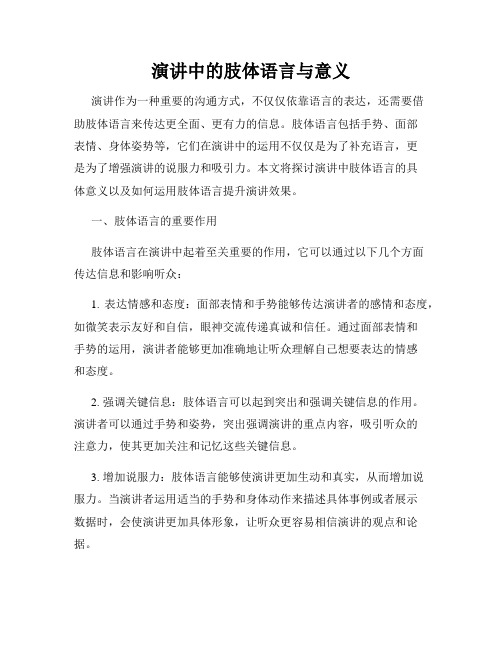
演讲中的肢体语言与意义演讲作为一种重要的沟通方式,不仅仅依靠语言的表达,还需要借助肢体语言来传达更全面、更有力的信息。
肢体语言包括手势、面部表情、身体姿势等,它们在演讲中的运用不仅仅是为了补充语言,更是为了增强演讲的说服力和吸引力。
本文将探讨演讲中肢体语言的具体意义以及如何运用肢体语言提升演讲效果。
一、肢体语言的重要作用肢体语言在演讲中起着至关重要的作用,它可以通过以下几个方面传达信息和影响听众:1. 表达情感和态度:面部表情和手势能够传达演讲者的感情和态度,如微笑表示友好和自信,眼神交流传递真诚和信任。
通过面部表情和手势的运用,演讲者能够更加准确地让听众理解自己想要表达的情感和态度。
2. 强调关键信息:肢体语言可以起到突出和强调关键信息的作用。
演讲者可以通过手势和姿势,突出强调演讲的重点内容,吸引听众的注意力,使其更加关注和记忆这些关键信息。
3. 增加说服力:肢体语言能够使演讲更加生动和真实,从而增加说服力。
当演讲者运用适当的手势和身体动作来描述具体事例或者展示数据时,会使演讲更加具体形象,让听众更容易相信演讲的观点和论据。
4. 与观众建立连接:演讲者通过肢体语言与听众建立视觉联系,可以增强与观众的互动和沟通。
与此同时,适当的手势和身体动作也可以打破演讲的沉闷感,让演讲更加生动有趣,从而提高听众的参与度和注意力。
二、肢体语言的运用技巧为了提升演讲效果,演讲者需要注意以下几个肢体语言的运用技巧:1. 保持自然:肢体语言要真实和自然,不要刻意和做作。
演讲者应该根据自己的个性和风格来运用肢体语言,让肢体动作与语言表达相协调,以展现出真诚和自信的形象。
2. 控制节奏和力度:手势和身体动作的节奏和力度应与言语相匹配。
演讲者可以通过缓慢和轻柔的动作来表达温和的观点,通过快速和有力的动作来表达激情和紧迫感。
3. 保持眼神交流:眼神交流是肢体语言中至关重要的一部分。
演讲者应该与观众保持眼神交流,这可以增强演讲的互动性和说服力。
amy cuddy ted演讲稿

三一文库()〔amy cuddy ted演讲稿〕amycuddyted演讲稿为大家整理哈佛商学院副教授amycuddy 在ted上的精彩演讲《用肢体语言塑造你自己,两分钟改变你的人生》,通过这篇演讲,让我们知道肢体语言的重要性,是如何影响我们的心理的。
下面是这篇amycuddyted演讲稿amycuddyted演讲稿我想要提供给你们一个免费的,非科技的人生窍门首先,我想要提供给你们一个免费的,非科技的人生窍门。
你只需这样做,改变你的姿势二分钟时间,但在我要把它告诉你们之前,我想要请你们,就你们的身体和你们身体的行为做一下自我审查。
那么你们之中有多少人正蜷缩着自己?或许你现在弓着背,还翘着二郎腿,或者双臂交叉。
有时候我们像这样抱住自己,有时候展开双臂,我看到你了。
现在请大家专心在自己的身上,我们等一下就会回溯刚刚的事,希望你们可以稍微改变一下,这会让你的生活变得很不一样。
所以,我们很真的很执着于肢体语言,特别是对别人的肢体语言感兴趣。
你看,我们对尴尬的互动,或一个微笑,或轻蔑的一瞥,或奇怪的眨眼,甚至是握手之类的事情感兴趣。
所以一个握手,或没有握手,我们都可以大聊特聊一番,即使BBC和纽约时报也不例外。
我们说到肢体行为或肢体语言时,我们将之归纳为社会科学,它就是一种语言。
所以我们会想到沟通,当我们想到沟通,我们就想到互动所以你现在的身体语言正在告诉我什么?我的身体又是在向你传达什么?有很多理由让我们相信这些是有效的,社会科学家花了很多时间,求证肢体语言的效果,或其它人的身体语言在判断方面的效应,而我们环视身体语言中的讯息做决定和推论。
这些结论可以预测生活中很有意义的结果,像是我们雇用谁或给谁升职,邀请谁出去约会,举例而言,Tufts大学的研究员,NaliniAmbady表示,人们观赏一部医生和患者互动的30秒无声影片。
进一步来说,普林斯顿的AlexTodorov表示,我们对政治人物脸部的喜好判断,大概可用来对美国参议院和美国州长的竞选结果做70%的预测,甚至就网络上在线聊天时使用的表情符号,可以帮助你从交谈中得到更多信息。
利用演讲中的肢体语言,增强说服力与表现力

利用演讲中的肢体语言,增强说服力与表现力引言在现代社会中,演讲已成为一项必不可少的沟通能力。
无论是商业演讲、学术演讲还是公众演讲,都需要我们用恰当的肢体语言来增强说服力和表现力。
本文将介绍一些利用演讲中的肢体语言的技巧,帮助你在演讲中更加自信和有力地传达观点。
什么是肢体语言肢体语言是指通过身体的姿势、动作、面部表情等非语言方式来表达意义和情感的一种沟通方式。
它能够帮助我们更直观地传达信息,强调重要观点,并与听众建立更紧密的联系。
重要的肢体语言技巧1. 姿势与站姿在演讲时,我们的姿势和站姿能够传递出我们的自信和权威感。
保持笔直的身体姿势,挺胸抬头,向前微微倾身可以让你显得更加自信和有力。
站在舞台中央,与听众保持一定的眼神接触,表现出你对听众的关注。
2. 手势手势是演讲中最常用的肢体语言之一。
使用恰当的手势可以帮助我们更好地强调观点和提供更具体的信息。
例如,可以用手指向某个方向来指明一个重要的观点,或者用手势来表示大小、形状等信息。
然而,要避免夸张或过于繁琐的手势,以免分散听众的注意力。
3. 面部表情面部表情是演讲中表达情感和思想的重要方式。
微笑可以建立与听众的亲和力,表达出自己的友善和开放态度。
同时,根据话题的性质,适时地改变面部表情也可以表达不同的情感,比如愤怒、忧虑或惊讶。
4. 眼神交流眼神交流是与听众建立密切联系的重要方式。
通过眼神交流,我们能够表达出对听众的尊重和关注,并使听众更加投入和专注。
在演讲中,尽量与听众保持眼神接触,扫视全场,确保每个人都感受到你的关注。
5. 声音与语调声音和语调虽然不属于肢体语言,但它们在演讲中同样重要,可以加强肢体语言的表达效果。
通过适当的音量和节奏,我们可以突出重点、调整情绪、吸引听众的注意力。
此外,还可以利用语调的起伏和变化来表达感情和强调观点。
总结利用演讲中的肢体语言,可以帮助我们提高演讲的说服力与表现力。
适当的姿势与站姿、手势、面部表情、眼神交流以及声音与语调的运用,都可以帮助我们更好地与听众建立联系,让观点更加生动有力地传达出去。
获奖感言之有效运用肢体语言的演讲技巧

获奖感言之有效运用肢体语言的演讲技巧尊敬的评委、亲爱的同学们:大家好!非常荣幸站在这个舞台上,与各位分享我的获奖感言。
今天,我想与大家一起探讨的话题是有效运用肢体语言的演讲技巧。
首先,让我们来认识一下肢体语言的重要性。
肢体语言是指通过身体的姿态、动作和表情等非语言元素来传递信息和情感的一种沟通方式。
在演讲中,人们对演讲者的注意力不仅仅停留在他们的言辞上,更注重与演讲者的肢体语言进行互动。
因此,在演讲过程中,有效地运用肢体语言可以更好地吸引观众的注意力,并增强演讲表达的效果。
那么,我将分享三个关于有效运用肢体语言的演讲技巧。
第一,自信的站姿。
站立是演讲的基本要素,合适的站姿能够彰显演讲者的自信和权威感。
首先,保持笔直的背部和挺直的身姿,让自己的形象展现出活力和自信。
同时,将双脚自然分开,与肩同宽,保持平衡感。
还要避免踱来踱去或者踩踏地板的习惯,这样会让人感觉到你的紧张和不自信。
总之,良好的站姿是演讲成功的第一步。
第二,生动的手势。
手是我们最为灵活的肢体工具,利用手势可以更加生动地表达思想和情感。
我们可以用手指定方向,画出形象,或者通过手势来强调关键点。
然而,手势的使用应该是自然而然的,而非刻意为之。
过多、过频的手势会分散听众的注意力,使演讲显得夸张和不正式。
因此,我们要谨慎、合理地运用手势,让它们与演讲内容相符,起到更好的表达效果。
第三,表情的力量。
脸是我们表达情感的窗口,通过面部表情,我们能够与观众建立更好的情感联系。
面带微笑可以传递友好和温暖,眼神交流能够拉近与观众的距离。
此外,我们可以通过面部的微妙变化,传达出不同的情感和体验,以引起听众的共鸣。
然而,虚伪的表情或者无视观众反馈的演讲者往往会让人感到不舒服,降低演讲的效果。
因此,在演讲中,我们要真实地展现自己的情感,并与观众建立良好的情感共鸣。
通过这三个演讲技巧,我相信你们也能感受到肢体语言在演讲中的力量和重要性。
在未来的演讲中,我希望大家能够有效地运用自己的肢体语言,展现出更加自信、生动和有吸引力的演讲表达。
演讲中肢体语言增添个人魅力
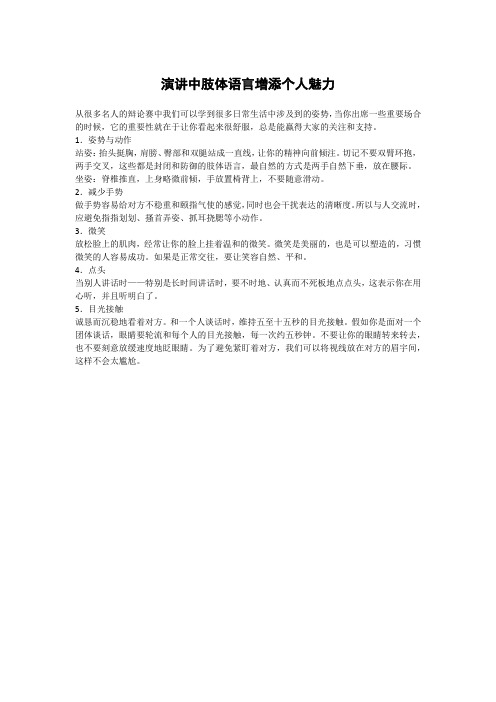
演讲中肢体语言增添个人魅力
从很多名人的辩论赛中我们可以学到很多日常生活中涉及到的姿势,当你出席一些重要场合的时候,它的重要性就在于让你看起来很舒服,总是能赢得大家的关注和支持。
1.姿势与动作
站姿:抬头挺胸,肩膀、臀部和双腿站成一直线,让你的精神向前倾注。
切记不要双臂环抱,两手交叉,这些都是封闭和防御的肢体语言,最自然的方式是两手自然下垂,放在腰际。
坐姿:脊椎推直,上身略微前倾,手放置椅背上,不要随意滑动。
2.减少手势
做手势容易给对方不稳重和颐指气使的感觉,同时也会干扰表达的清晰度。
所以与人交流时,应避免指指划划、搔首弄姿、抓耳挠腮等小动作。
3.微笑
放松脸上的肌肉,经常让你的脸上挂着温和的微笑。
微笑是美丽的,也是可以塑造的,习惯微笑的人容易成功。
如果是正常交往,要让笑容自然、平和。
4.点头
当别人讲话时——特别是长时间讲话时,要不时地、认真而不死板地点点头,这表示你在用心听,并且听明白了。
5.目光接触
诚恳而沉稳地看着对方。
和一个人谈话时,维持五至十五秒的目光接触。
假如你是面对一个团体谈话,眼睛要轮流和每个人的目光接触,每一次约五秒钟。
不要让你的眼睛转来转去,也不要刻意放缓速度地眨眼睛。
为了避免紧盯着对方,我们可以将视线放在对方的眉宇间,这样不会太尴尬。
发言稿中的肢体语言增强演讲的表达力
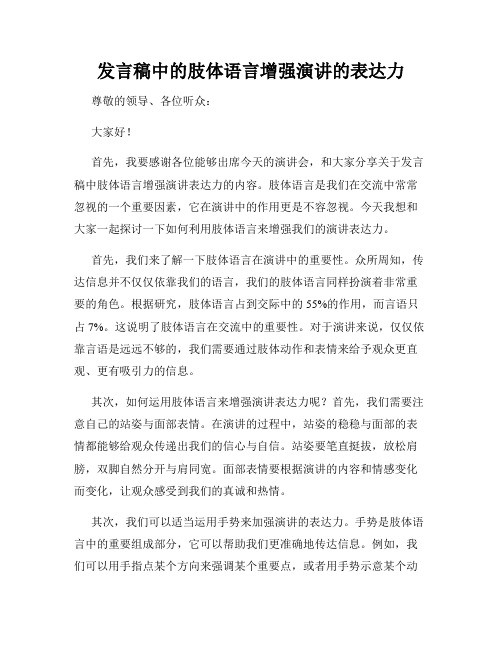
发言稿中的肢体语言增强演讲的表达力尊敬的领导、各位听众:大家好!首先,我要感谢各位能够出席今天的演讲会,和大家分享关于发言稿中肢体语言增强演讲表达力的内容。
肢体语言是我们在交流中常常忽视的一个重要因素,它在演讲中的作用更是不容忽视。
今天我想和大家一起探讨一下如何利用肢体语言来增强我们的演讲表达力。
首先,我们来了解一下肢体语言在演讲中的重要性。
众所周知,传达信息并不仅仅依靠我们的语言,我们的肢体语言同样扮演着非常重要的角色。
根据研究,肢体语言占到交际中的55%的作用,而言语只占7%。
这说明了肢体语言在交流中的重要性。
对于演讲来说,仅仅依靠言语是远远不够的,我们需要通过肢体动作和表情来给予观众更直观、更有吸引力的信息。
其次,如何运用肢体语言来增强演讲表达力呢?首先,我们需要注意自己的站姿与面部表情。
在演讲的过程中,站姿的稳稳与面部的表情都能够给观众传递出我们的信心与自信。
站姿要笔直挺拔,放松肩膀,双脚自然分开与肩同宽。
面部表情要根据演讲的内容和情感变化而变化,让观众感受到我们的真诚和热情。
其次,我们可以适当运用手势来加强演讲的表达力。
手势是肢体语言中的重要组成部分,它可以帮助我们更准确地传达信息。
例如,我们可以用手指点某个方向来强调某个重要点,或者用手势示意某个动作,让观众更好地理解我们的意思。
但是需要注意的是,手势要适度,过多的手势可能会让人分散注意力。
此外,我们的眼神交流也是非常重要的。
通过眼神交流,我们能够与听众建立更好的联系,让演讲更加生动和引人入胜。
当我们演讲时,可以尽量多地与观众进行目光交流,表达出我们对观众的关注和尊重。
这样不仅可以增强我们演讲的表达力,也能够更好地与观众互动。
最后,我想强调的是,肢体语言的运用需要我们的练习和实践。
只有通过不断地练习,我们才能够更好地掌握肢体语言的技巧,并且在演讲中自如地运用起来。
切记,实践是掌握肢体语言的关键,只有不断地实践,相信我们一定能够在演讲中展现出更好的演讲表达力。
演讲中的肢体语言打造自信形象
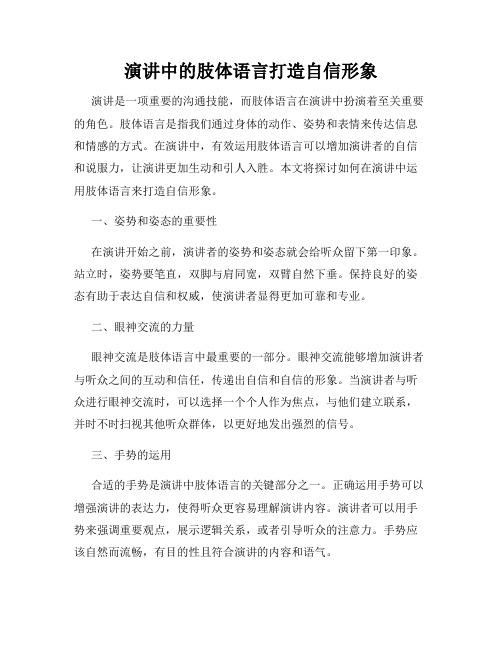
演讲中的肢体语言打造自信形象演讲是一项重要的沟通技能,而肢体语言在演讲中扮演着至关重要的角色。
肢体语言是指我们通过身体的动作、姿势和表情来传达信息和情感的方式。
在演讲中,有效运用肢体语言可以增加演讲者的自信和说服力,让演讲更加生动和引人入胜。
本文将探讨如何在演讲中运用肢体语言来打造自信形象。
一、姿势和姿态的重要性在演讲开始之前,演讲者的姿势和姿态就会给听众留下第一印象。
站立时,姿势要笔直,双脚与肩同宽,双臂自然下垂。
保持良好的姿态有助于表达自信和权威,使演讲者显得更加可靠和专业。
二、眼神交流的力量眼神交流是肢体语言中最重要的一部分。
眼神交流能够增加演讲者与听众之间的互动和信任,传递出自信和自信的形象。
当演讲者与听众进行眼神交流时,可以选择一个个人作为焦点,与他们建立联系,并时不时扫视其他听众群体,以更好地发出强烈的信号。
三、手势的运用合适的手势是演讲中肢体语言的关键部分之一。
正确运用手势可以增强演讲的表达力,使得听众更容易理解演讲内容。
演讲者可以用手势来强调重要观点,展示逻辑关系,或者引导听众的注意力。
手势应该自然而流畅,有目的性且符合演讲的内容和语气。
四、面部表情的影响力面部表情是肢体语言中最直接传递情感的方式之一。
面部表情可以帮助演讲者更准确地传达信息,并与听众建立情感联系。
演讲时,要保持自然的微笑,面带自信和友善的表情。
根据演讲的内容和情感变化,演讲者可以适时调整面部表情,以更好地表达自己的思想和观点。
五、姿态和移动的协调在演讲中,姿态和移动的协调也是非常重要的。
演讲者可以运用适当的姿态和移动来增加活跃度和动感。
在强调重要观点时,可以稍微前倾身体;在转换话题时,可以适度的移动位置。
但同时,要注意不要过于频繁地变换姿态和位置,以免分散听众的注意力。
六、声音与肢体的和谐演讲者的声音和肢体动作应该相互协调。
当演讲者强调重要观点时,声音可以加强手势的效果。
例如,当强调“非常重要”时,可以用有力的声音和手势来强调这一点。
TED演讲:用肢体语言来塑造自己
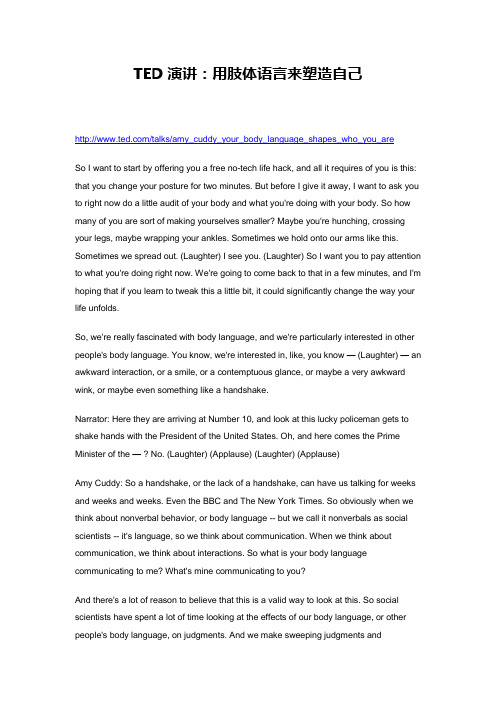
TED演讲:用肢体语言来塑造自己/talks/amy_cuddy_your_body_language_shapes_who_you_areSo I want to start by offering you a free no-tech life hack, and all it requires of you is this: that you change your posture for two minutes. But before I give it away, I want to ask you to right now do a little audit of your body and what you're doing with your body. So how many of you are sort of making yourselves smaller? Maybe you're hunching, crossing your legs, maybe wrapping your ankles. Sometimes we hold onto our arms like this. Sometimes we spread out. (Laughter) I see you. (Laughter) So I want you to pay attention to what you're doing right now. We're going to come back to that in a few minutes, and I'm hoping that if you learn to tweak this a little bit, it could significantly change the way your life unfolds.So, we're really fascinated with body language, and we're particularly interested in other people's body language. You know, we're interested in, like, you know — (Laughter) — an awkward interaction, or a smile, or a contemptuous glance, or maybe a very awkward wink, or maybe even something like a handshake.Narrator: Here they are arriving at Number 10, and look at this lucky policeman gets to shake hands with the President of the United States. Oh, and here comes the Prime Minister of the — ? No. (Laughter) (Applause) (Laughter) (Applause)Amy Cuddy: So a handshake, or the lack of a handshake, can have us talking for weeks and weeks and weeks. Even the BBC and The New York Times. So obviously when we think about nonverbal behavior, or body language -- but we call it nonverbals as social scientists -- it's language, so we think about communication. When we think about communication, we think about interactions. So what is your body language communicating to me? What's mine communicating to you?And there's a lot of reason to believe that this is a valid way to look at this. So social scientists have spent a lot of time looking at the effects of our body language, or other people's body language, on judgments. And we make sweeping judgments andinferences from body language. And those judgments can predict really meaningful life outcomes like who we hire or promote, who we ask out on a date. For example, Nalini Ambady, a researcher at Tufts University, shows that when people watch 30-second soundless clips of real physician-patient interactions, their judgments of the physician's niceness predict whether or not that physician will be sued. So it doesn't have to do so much with whether or not that physician was incompetent, but do we like that person and how they interacted? Even more dramatic, Alex Todorov at Princeton has shown us that judgments of political candidates' faces in just one second predict 70 percent of U.S. Senate and gubernatorial race outcomes, and even, let's go digital, emoticons used well in online negotiations can lead to you claim more value from that negotiation. If you use them poorly, bad idea. Right? So when we think of nonverbals, we think of how we judge others, how they judge us and what the outcomes are. We tend to forget, though, the other audience that's influenced by our nonverbals, and that's ourselves.We are also influenced by our nonverbals, our thoughts and our feelings and our physiology. So what nonverbals am I talking about? I'm a social psychologist. I study prejudice, and I teach at a competitive business school, so it was inevitable that I would become interested in power dynamics. I became especially interested in nonverbal expressions of power and dominance.And what are nonverbal expressions of power and dominance? Well, this is what they are. So in the animal kingdom, they are about expanding. So you make yourself big, you stretch out, you take up space, you're basically opening up. It's about opening up. And this is true across the animal kingdom. It's not just limited to primates. And humans do the same thing. (Laughter) So they do this both when they have power sort of chronically, and also when they're feeling powerful in the moment. And this one is especially interesting because it really shows us how universal and old these expressions of power are. This expression, which is known as pride, Jessica Tracy has studied. She shows that people who are born with sight and people who are congenitally blind do this when they win at a physical competition. So when they cross the finish line and they've won, it doesn't matter if they've never seen anyone do it. They do this. So the arms up in the V, the chin is slightly lifted. What do we do when we feel powerless? We do exactly the opposite. We close up. We wrap ourselves up. We make ourselves small. We don't want to bump intothe person next to us. So again, both animals and humans do the same thing. And this is what happens when you put together high and low power. So what we tend to do when it comes to power is that we complement the other's nonverbals. So if someone is being really powerful with us, we tend to make ourselves smaller. We don't mirror them. We do the opposite of them.So I'm watching this behavior in the classroom, and what do I notice? I notice that MBA students really exhibit the full range of power nonverbals. So you have people who are like caricatures of alphas, really coming into the room, they get right into the middle of the room before class even starts, like they really want to occupy space. When they sit down, they're sort of spread out. They raise their hands like this. You have other people who are virtually collapsing when they come in. As soon they come in, you see it. You see it on their faces and their bodies, and they sit in their chair and they make themselves tiny, and they go like this when they raise their hand. I notice a couple of things about this. One, you're not going to be surprised. It seems to be related to gender. So women are much more likely to do this kind of thing than men. Women feel chronically less powerful than men, so this is not surprising. But the other thing I noticed is that it also seemed to be related to the extent to which the students were participating, and how well they were participating. And this is really important in the MBA classroom, because participation counts for half the grade.So business schools have been struggling with this gender grade gap. You get these equally qualified women and men coming in and then you get these differences in grades, and it seems to be partly attributable to participation. So I started to wonder, you know, okay, so you have these people coming in like this, and they're participating. Is it possible that we could get people to fake it and would it lead them to participate more?So my main collaborator Dana Carney, who's at Berkeley, and I really wanted to know, can you fake it till you make it? Like, can you do this just for a little while and actually experience a behavioral outcome that makes you seem more powerful? So we know that our nonverbals govern how other people think and feel about us. There's a lot of evidence. But our question really was, do our nonverbals govern how we think and feel about ourselves?There's some evidence that they do. So, for example, we smile when we feel happy, but also, when we're forced to smile by holding a pen in our teeth like this, it makes us feel happy. So it goes both ways. When it comes to power, it also goes both ways. So when you feel powerful, you're more likely to do this, but it's also possible that when you pretend to be powerful, you are more likely to actually feel powerful.So the second question really was, you know, so we know that our minds change our bodies, but is it also true that our bodies change our minds? And when I say minds, in the case of the powerful, what am I talking about? So I'm talking about thoughts and feelings and the sort of physiological things that make up our thoughts and feelings, and in my case, that's hormones. I look at hormones. So what do the minds of the powerful versus the powerless look like? So powerful people tend to be, not surprisingly, more assertive and more confident, more optimistic. They actually feel that they're going to win even at games of chance. They also tend to be able to think more abstractly. So there are a lot of differences. They take more risks. There are a lot of differences between powerful and powerless people. Physiologically, there also are differences on two key hormones: testosterone, which is the dominance hormone, and cortisol, which is the stress hormone. So what we find is that high-power alpha males in primate hierarchies have high testosterone and low cortisol, and powerful and effective leaders also have high testosterone and low cortisol. So what does that mean? When you think about power, people tended to think only about testosterone, because that was about dominance. But really, power is also about how you react to stress. So do you want the high-power leader that's dominant, high on testosterone, but really stress reactive? Probably not, right? You want the person who's powerful and assertive and dominant, but not very stress reactive, the person who's laid back.So we know that in primate hierarchies, if an alpha needs to take over, if an individual needs to take over an alpha role sort of suddenly, within a few days, that individual's testosterone has gone up significantly and his cortisol has dropped significantly. So we have this evidence, both that the body can shape the mind, at least at the facial level, and also that role changes can shape the mind. So what happens, okay, you take a role change, what happens if you do that at a really minimal level, like this tiny manipulation,this tiny intervention? "For two minutes," you say, "I want you to stand like this, and it's going to make you feel more powerful."So this is what we did. We decided to bring people into the lab and run a little experiment, and these people adopted, for two minutes, either high-power poses or low-power poses, and I'm just going to show you five of the poses, although they took on only two. So here's one. A couple more. This one has been dubbed the "Wonder Woman" by the media. Here are a couple more. So you can be standing or you can be sitting. And here are thelow-power poses. So you're folding up, you're making yourself small. This one is verylow-power. When you're touching your neck, you're really protecting yourself. So this is what happens. They come in, they spit into a vial, we for two minutes say, "You need to do this or this." They don't look at pictures of the poses. We don't want to prime them with a concept of power. We want them to be feeling power, right? So two minutes they do this. We then ask them, "How powerful do you feel?" on a series of items, and then we give them an opportunity to gamble, and then we take another saliva sample. That's it. That's the whole experiment.So this is what we find. Risk tolerance, which is the gambling, what we find is that when you're in the high-power pose condition, 86 percent of you will gamble. When you're in the low-power pose condition, only 60 percent, and that's a pretty whopping significant difference. Here's what we find on testosterone. From their baseline when they come in, high-power people experience about a 20-percent increase, and low-power people experience about a 10-percent decrease. So again, two minutes, and you get these changes. Here's what you get on cortisol. High-power people experience about a25-percent decrease, and the low-power people experience about a 15-percent increase. So two minutes lead to these hormonal changes that configure your brain to basically be either assertive, confident and comfortable, or really stress-reactive, and, you know, feeling sort of shut down. And we've all had the feeling, right? So it seems that our nonverbals do govern how we think and feel about ourselves, so it's not just others, but it's also ourselves. Also, our bodies change our minds.But the next question, of course, is can power posing for a few minutes really change your life in meaningful ways? So this is in the lab. It's this little task, you know, it's just a couple of minutes. Where can you actually apply this? Which we cared about, of course. And sowe think it's really, what matters, I mean, where you want to use this is evaluative situations like social threat situations. Where are you being evaluated, either by your friends? Like for teenagers it's at the lunchroom table. It could be, you know, for some people it's speaking at a school board meeting. It might be giving a pitch or giving a talk like this or doing a job interview. We decided that the one that most people could relate to because most people had been through was the job interview.So we published these findings, and the media are all over it, and they say, Okay, so this is what you do when you go in for the job interview, right? (Laughter) You know, so we were of course horrified, and said, Oh my God, no, no, no, that's not what we meant at all. For numerous reasons, no, no, no, don't do that. Again, this is not about you talking to other people. It's you talking to yourself. What do you do before you go into a job interview? You do this. Right? You're sitting down. You're looking at your iPhone -- or your Android, not trying to leave anyone out. You are, you know, you're looking at your notes, you're hunching up, making yourself small, when really what you should be doing maybe is this, like, in the bathroom, right? Do that. Find two minutes. So that's what we want to test. Okay? So we bring people into a lab, and they do either high- or low-power poses again, they go through a very stressful job interview. It's five minutes long. They are being recorded. They're being judged also, and the judges are trained to give no nonverbal feedback, so they look like this. Like, imagine this is the person interviewing you. So for five minutes, nothing, and this is worse than being heckled. People hate this. It's what Marianne LaFrance calls "standing in social quicksand." So this really spikes your cortisol. So this is the job interview we put them through, because we really wanted to see what happened. We then have these coders look at these tapes, four of them. They're blind to the hypothesis. They're blind to the conditions. They have no idea who's been posing in what pose, and they end up looking at these sets of tapes, and they say, "Oh, we want to hire these people," -- all the high-power posers -- "we don't want to hire these people. We also evaluate these people much more positively overall." But what's driving it? It's not about the content of the speech. It's about the presence that they're bringing to the speech. We also, because we rate them on all these variables related to competence, like, how well-structured is the speech? How good is it? What are their qualifications? No effect on those things. This is what's affected. These kinds of things. People are bringing their true selves, basically. They're bringing themselves. They bring their ideas, but as themselves,with no, you know, residue over them. So this is what's driving the effect, or mediating the effect.So when I tell people about this, that our bodies change our minds and our minds can change our behavior, and our behavior can change our outcomes, they say to me, "I don't -- It feels fake." Right? So I said, fake it till you make it. I don't -- It's not me. I don't want to get there and then still feel like a fraud. I don't want to feel like an impostor. I don't want to get there only to feel like I'm not supposed to be here. And that really resonated with me, because I want to tell you a little story about being an impostor and feeling like I'm not supposed to be here.When I was 19, I was in a really bad car accident. I was thrown out of a car, rolled several times. I was thrown from the car. And I woke up in a head injury rehab ward, and I had been withdrawn from college, and I learned that my I.Q. had dropped by two standard deviations, which was very traumatic. I knew my I.Q. because I had identified with being smart, and I had been called gifted as a child. So I'm taken out of college, I keep trying to go back. They say, "You're not going to finish college. Just, you know, there are other things for you to do, but that's not going to work out for you." So I really struggled with this, and I have to say, having your identity taken from you, your core identity, and for me it was being smart, having that taken from you, there's nothing that leaves you feeling more powerless than that. So I felt entirely powerless. I worked and worked and worked, and I got lucky, and worked, and got lucky, and worked.Eventually I graduated from college. It took me four years longer than my peers, and I convinced someone, my angel advisor, Susan Fiske, to take me on, and so I ended up at Princeton, and I was like, I am not supposed to be here. I am an impostor. And the night before my first-year talk, and the first-year talk at Princeton is a 20-minute talk to 20 people. That's it. I was so afraid of being found out the next day that I called her and said, "I'm quitting." She was like, "You are not quitting, because I took a gamble on you, and you're staying. You're going to stay, and this is what you're going to do. You are going to fake it. You're going to do every talk that you ever get asked to do. You're just going to do it and do it and do it, even if you're terrified and just paralyzed and having an out-of-body experience, until you have this moment where you say, 'Oh my gosh, I'm doing it. Like, I have become this. I am actually doing this.'" So that's what I did. Five years in grad school,a few years, you know, I'm at Northwestern, I moved to Harvard, I'm at Harvard, I'm not really thinking about it anymore, but for a long time I had been thinking, "Not supposed to be here. Not supposed to be here."So at the end of my first year at Harvard, a student who had not talked in class the entire semester, who I had said, "Look, you've gotta participate or else you're going to fail," came into my office. I really didn't know her at all. And she said, she came in totally defeated, and she said, "I'm not supposed to be here." And that was the moment for me. Because two things happened. One was that I realized, oh my gosh, I don't feel like that anymore. You know. I don't feel that anymore, but she does, and I get that feeling. And the second was, she is supposed to be here! Like, she can fake it, she can become it. So I was like, "Yes, you are! You are supposed to be here! And tomorrow you're going to fake it, you're going to make yourself powerful, and, you know, you're gonna — " (Applause) (Applause) "And you're going to go into the classroom, and you are going to give the best comment ever." You know? And she gave the best comment ever, and people turned around and they were like, oh my God, I didn't even notice her sitting there, you know? (Laughter)She comes back to me months later, and I realized that she had not just faked it till she made it, she had actually faked it till she became it. So she had changed. And so I want to say to you, don't fake it till you make it. Fake it till you become it. You know? It's not — Do it enough until you actually become it and internalize.The last thing I'm going to leave you with is this. Tiny tweaks can lead to big changes. So this is two minutes. Two minutes, two minutes, two minutes. Before you go into the next stressful evaluative situation, for two minutes, try doing this, in the elevator, in a bathroom stall, at your desk behind closed doors. That's what you want to do. Configure your brain to cope the best in that situation. Get your testosterone up. Get your cortisol down. Don't leave that situation feeling like, oh, I didn't show them who I am. Leave that situation feeling like, oh, I really feel like I got to say who I am and show who I am.So I want to ask you first, you know, both to try power posing, and also I want to ask you to share the science, because this is simple. I don't have ego involved in this. (Laughter) Give it away. Share it with people, because the people who can use it the most are theones with no resources and no technology and no status and no power. Give it to them because they can do it in private. They need their bodies, privacy and two minutes, and it can significantly change the outcomes of their life. Thank you. (Applause) (Applause)所以我想先向你提供一个免费的高科技生活,所有这一切都需要你的是:你要改变你的姿势2分钟。
心理课之肢体语言教育心得
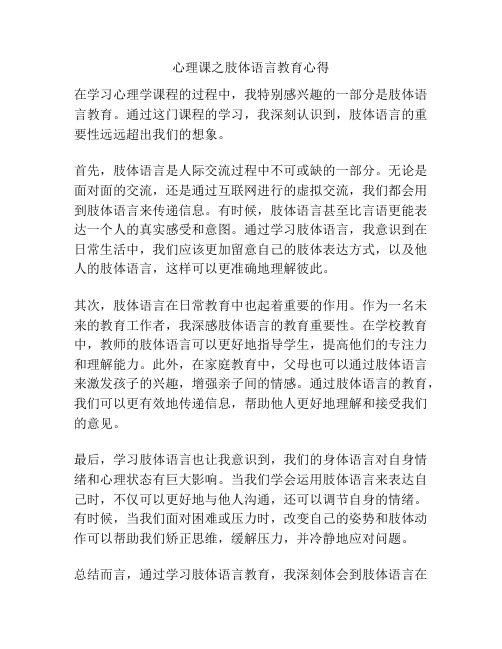
心理课之肢体语言教育心得
在学习心理学课程的过程中,我特别感兴趣的一部分是肢体语言教育。
通过这门课程的学习,我深刻认识到,肢体语言的重要性远远超出我们的想象。
首先,肢体语言是人际交流过程中不可或缺的一部分。
无论是面对面的交流,还是通过互联网进行的虚拟交流,我们都会用到肢体语言来传递信息。
有时候,肢体语言甚至比言语更能表达一个人的真实感受和意图。
通过学习肢体语言,我意识到在日常生活中,我们应该更加留意自己的肢体表达方式,以及他人的肢体语言,这样可以更准确地理解彼此。
其次,肢体语言在日常教育中也起着重要的作用。
作为一名未来的教育工作者,我深感肢体语言的教育重要性。
在学校教育中,教师的肢体语言可以更好地指导学生,提高他们的专注力和理解能力。
此外,在家庭教育中,父母也可以通过肢体语言来激发孩子的兴趣,增强亲子间的情感。
通过肢体语言的教育,我们可以更有效地传递信息,帮助他人更好地理解和接受我们的意见。
最后,学习肢体语言也让我意识到,我们的身体语言对自身情绪和心理状态有巨大影响。
当我们学会运用肢体语言来表达自己时,不仅可以更好地与他人沟通,还可以调节自身的情绪。
有时候,当我们面对困难或压力时,改变自己的姿势和肢体动作可以帮助我们矫正思维,缓解压力,并冷静地应对问题。
总结而言,通过学习肢体语言教育,我深刻体会到肢体语言在
人际交流和教育中的重要性。
我将继续努力将这种肢体语言的教育应用于自己的学习和未来的教育工作中,并希望能够帮助更多人更好地理解和运用肢体语言。
TED一篇观后感:Yourbodylanguageshapeswhoyouare肢体语言塑造人格
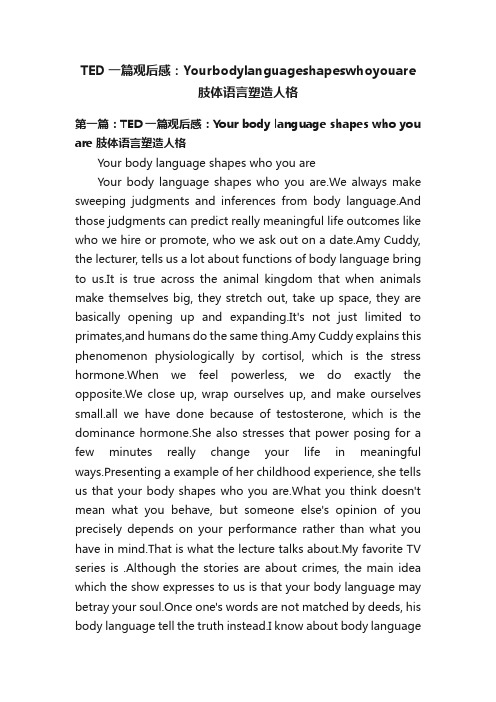
TED一篇观后感:Yourbodylanguageshapeswhoyouare肢体语言塑造人格第一篇:TED一篇观后感:Your body language shapes who you are 肢体语言塑造人格Your body language shapes who you areYour body language shapes who you are.We always make sweeping judgments and inferences from body language.And those judgments can predict really meaningful life outcomes like who we hire or promote, who we ask out on a date.Amy Cuddy, the lecturer, tells us a lot about functions of body language bring to us.It is true across the animal kingdom that when animals make themselves big, they stretch out, take up space, they are basically opening up and expanding.It's not just limited to primates,and humans do the same thing.Amy Cuddy explains this phenomenon physiologically by cortisol, which is the stress hormone.When we feel powerless, we do exactly the opposite.We close up, wrap ourselves up, and make ourselves small.all we have done because of testosterone, which is the dominance hormone.She also stresses that power posing for a few minutes really change your life in meaningful ways.Presenting a example of her childhood experience, she tells us that your body shapes who you are.What you think doesn't mean what you behave, but someone else's opinion of you precisely depends on your performance rather than what you have in mind.That is what the lecture talks about.My favorite TV series is .Although the stories are about crimes, the main idea which the show expresses to us is that your body language may betray your soul.Once one's words are not matched by deeds, his body language tell the truth instead.I know about body languageonly stay at this level:your body language reflects who you are.Through Amy Cuddy's speech, I understand much deeper:your body language not only reflects who you are, but also shapes who you are.Since we have found the body language can accurately reflect our inner emotion condition, we can also make the body language a positive means, which motivates our psychological status to be better.People feel tense when Cortisol level is high, so they may curl up body or dodge themselves as physical reaction.On the contrast, if we pretend to be relax and confident, making body language roused, opening shoulders, and smiling with ease, then our testosterone level will rise while cortisol will be inhibited.T o some extent, once we faked to be relax and confident, one day it will become real.As Amy said, ‘Fake it till you make it.Fake it till you become it.’I cannot agree more about her idea, because I had the same experience before.After graduated from primary school, my character totally changed, which due to a person.She is the one I admired most in primary school because she can be very confident in any occasion.Everyday she raised her head proudly, talked with others in humorous way and acted neither humble nor pushy just like a queen.However, i usually curled up in my seat, looked down as answering questions, dared not contact with the one's eyes.It is cortisol that plays the main role, which leads us to be powerless.When I came to middle school, I started to change.I pretended to be another her though I know I am an impostor, I still tried to appear confident and brave.I faked it till I made it, and finally one day I really became it.Learning to tweak this a little bit, it could significantly change the way your life unfolds.So I want to say, rising your head proudly, opening your shoulder with confidence, holding your hands up to top,answering questions as loudly as you can.You are what you do.You are what you say.You are what your body language expresses, because your body language shapes who you are.第二篇:肢体语言肢体语言在职业学校英语教学中的作用摘要:随着语言教学和语言学习方法改革的持续推进,对于英语教师用英语组织教学创设鲜活的语言学习环境的要求越来越高,然而由于职业学校学生英语基础普遍欠佳,词汇量相对匮乏,这就要求老师必须通过面部表情和肢体语言,来简化教学语言,本文将探讨肢体语言在职业学校英语教学中运用的可行性和效果。
演讲中的身体语言如何利用肢体表达增强演讲效果

演讲中的身体语言如何利用肢体表达增强演讲效果演讲是一种重要的沟通方式,除了言辞之外,身体语言在演讲中起着至关重要的作用。
通过肢体表达,演讲者能够传达出更加生动、自信和有力的信息,从而有效地增强演讲效果。
本文将探讨演讲中如何利用肢体表达来提升演讲效果。
一、姿势与姿态的重要性演讲者的姿势与姿态是演讲时的第一印象,也是观众对演讲者形象的一种评价。
一个笔直、自信的站姿能够展现演讲者的自信和权威感,给观众带来积极的影响。
此外,演讲者的手势也是传达信息的重要方式,适当的手势能够增强演讲语言的表现力,使观众更好地理解演讲者所传达的思想和情感。
二、面部表情的运用面部表情是与观众进行直接接触的重要方式,可以更好地激发观众的共鸣和情感共鸣。
演讲者要学会运用丰富的面部表情,包括微笑、眉毛的抬起、眼神的注视等,通过表情的变化,传递自己内心情感的真实性和强烈性。
适时地运用面部表情,能够增强观众对演讲内容的关注度和理解度。
三、身体姿势的运用演讲者可以通过身体姿势的变化,来突出演讲的重点和表达的情感。
例如,演讲者可以选择走动或停留在舞台的不同位置,通过身体在空间中的移动,来吸引观众的目光,同时展现出自己的激情和自信。
此外,身体的动作和姿势的变化,也可以用来强调演讲中的重要观点和论据,使观众更好地理解和接受演讲内容。
四、声音与姿势的协调在演讲中,演讲者的声音与姿势需要协调一致,才能更好地传递信息和感染观众。
例如,在强调某个重要观点时,演讲者可以通过加大声音的音量和提高音调的高低来强调其重要性,同时配合相应的手势和身体姿势,以增强表达效果。
声音和姿势的协调运用,能够使演讲者的语言与身体表达产生更好的互动效果,从而更好地引导观众的关注和理解。
五、与观众的眼神交流与观众进行眼神交流是演讲中十分重要的一环。
通过目光的交流,演讲者能够与观众建立更直接、更亲密的沟通联系,加深演讲的互动性和吸引力。
演讲者应该时刻保持目光的活跃性,保持与观众的眼神交流,同时注意观众的反馈,根据观众的反应来调整自己的表达方式和节奏,以促进演讲效果的最大化。
英文演讲中如何使用肢体语言作文
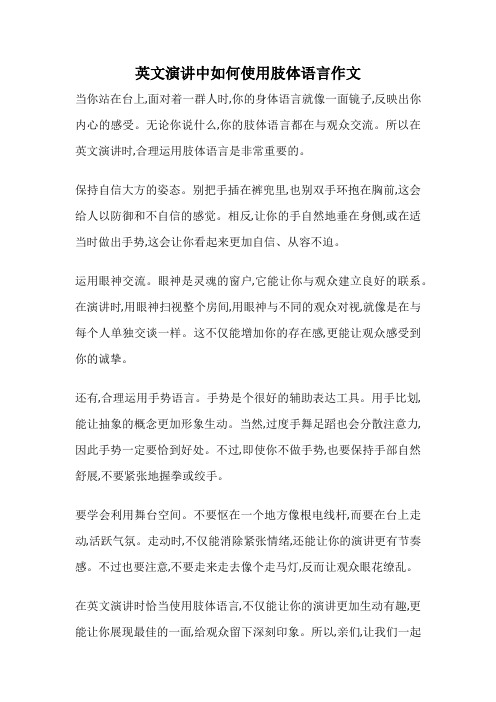
英文演讲中如何使用肢体语言作文
当你站在台上,面对着一群人时,你的身体语言就像一面镜子,反映出你内心的感受。
无论你说什么,你的肢体语言都在与观众交流。
所以在英文演讲时,合理运用肢体语言是非常重要的。
保持自信大方的姿态。
别把手插在裤兜里,也别双手环抱在胸前,这会给人以防御和不自信的感觉。
相反,让你的手自然地垂在身侧,或在适当时做出手势,这会让你看起来更加自信、从容不迫。
运用眼神交流。
眼神是灵魂的窗户,它能让你与观众建立良好的联系。
在演讲时,用眼神扫视整个房间,用眼神与不同的观众对视,就像是在与每个人单独交谈一样。
这不仅能增加你的存在感,更能让观众感受到你的诚挚。
还有,合理运用手势语言。
手势是个很好的辅助表达工具。
用手比划,能让抽象的概念更加形象生动。
当然,过度手舞足蹈也会分散注意力,因此手势一定要恰到好处。
不过,即使你不做手势,也要保持手部自然舒展,不要紧张地握拳或绞手。
要学会利用舞台空间。
不要怄在一个地方像根电线杆,而要在台上走动,活跃气氛。
走动时,不仅能消除紧张情绪,还能让你的演讲更有节奏感。
不过也要注意,不要走来走去像个走马灯,反而让观众眼花缭乱。
在英文演讲时恰当使用肢体语言,不仅能让你的演讲更加生动有趣,更能让你展现最佳的一面,给观众留下深刻印象。
所以,亲们,让我们一起
用身体语言来作文吧!。
演讲中的肢体语言 如何展现自信与魅力
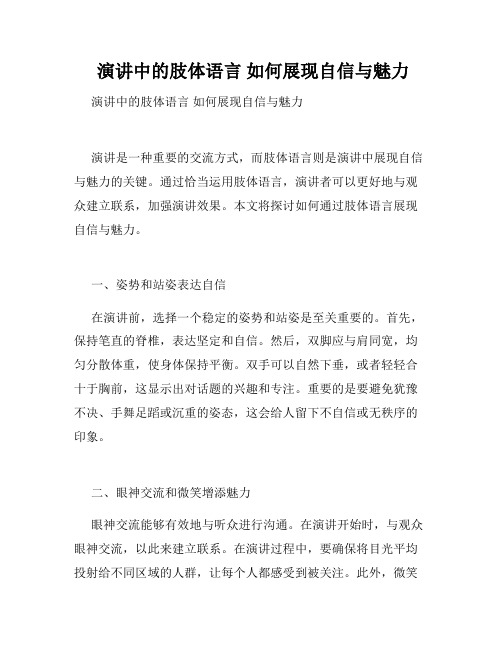
演讲中的肢体语言如何展现自信与魅力演讲中的肢体语言如何展现自信与魅力演讲是一种重要的交流方式,而肢体语言则是演讲中展现自信与魅力的关键。
通过恰当运用肢体语言,演讲者可以更好地与观众建立联系,加强演讲效果。
本文将探讨如何通过肢体语言展现自信与魅力。
一、姿势和站姿表达自信在演讲前,选择一个稳定的姿势和站姿是至关重要的。
首先,保持笔直的脊椎,表达坚定和自信。
然后,双脚应与肩同宽,均匀分散体重,使身体保持平衡。
双手可以自然下垂,或者轻轻合十于胸前,这显示出对话题的兴趣和专注。
重要的是要避免犹豫不决、手舞足蹈或沉重的姿态,这会给人留下不自信或无秩序的印象。
二、眼神交流和微笑增添魅力眼神交流能够有效地与听众进行沟通。
在演讲开始时,与观众眼神交流,以此来建立联系。
在演讲过程中,要确保将目光平均投射给不同区域的人群,让每个人都感受到被关注。
此外,微笑也是展现自信和魅力的关键。
微笑不仅可以给予观众温暖与友好的感受,还能缓解紧张情绪,提升演讲的氛围。
三、手势的运用增强表达力手势是演讲中非常有力的表达工具。
适当的手势可以帮助演讲者更好地传达信息和观点。
比如,当演讲者想强调某一点时,可以用指示手势或者双手划重点。
当提到不同的选择或对立观点时,可以使用对比手势。
另外,手势与语言相结合,可以增加演讲的可信度和说服力。
但是,手势要避免过度或者不自然,以免干扰观众对演讲的理解和专注。
四、动作的平稳与韵律感演讲中的动作应该平稳流畅,并具备一定的韵律感。
过于急促的动作会给人感觉紧张,而过于缓慢的动作则会使演讲显得无聊乏味。
要有意识地控制自己的动作速度,使动作与演讲的内容相协调,展现出自信与魅力。
此外,变换动作的频率和幅度也是展示魅力的重要手段之一。
适当的变化将吸引观众的注意力,使演讲更加生动有趣。
五、姿态调整与舞台运用不同的姿态和舞台运用可以帮助演讲者更好地展示自信与魅力。
当演讲话题需要展示自己的权威与专业性时,可以选择站立或坐下,保持端庄和垂直的身体姿态。
发言稿中的肢体语言技巧:提升演讲的表达力

发言稿中的肢体语言技巧:提升演讲的表达力尊敬的各位领导、来宾和各位同事们:大家好!很荣幸今天能够在这里和大家一起分享有关肢体语言技巧的发言稿。
肢体语言是人类交流中不可或缺的一部分,它能够帮助我们更好地表达自己,提升演讲的表达力。
在接下来的时间里,我将和大家分享一些肢体语言技巧,希望对大家在演讲中的表达能力有所帮助。
首先,一个自信而直立的身姿。
我们都知道,人的身体语言能够传递出一种情感和氛围。
当我们站立时,要保持一个自信、挺直的姿势。
站立时,要让肩膀放松,收腹挺胸,保持头颈部的舒展。
这样的姿势不仅能够让我们自己感受到自信,也能够给观众一种稳重有力的感觉。
其次,眼神交流是很重要的。
当我们演讲时,要学会与观众进行眼神交流。
可以逐个扫视观众,确保每个人都能感受到你的目光。
同时,我们要保持微笑并保持镇定。
这样的眼神交流不仅能够凝聚观众的注意力,还可以表达出自己的诚意和自信。
另外,手势的运用也是很关键的。
我们可以利用手势来强调观点,使内容更加生动。
当我们想强调某一部分的时候,可以用手势来指向该部分。
当我们想表达时间的先后顺序时,可以用手势来模拟时间的流逝。
当我们想表达某种感觉时,可以用手势来表现出来。
总之,手势的运用可以帮助我们更好地传达自己的信息,加强与观众之间的互动和理解。
除了以上的技巧,面部表情的运用也是很重要的。
面部表情能够传递出我们的情感和态度。
当我们演讲时,要保持微笑,展现出自己的自信和友好。
当我们想表达严肃的时候,面部表情也要相应地调整。
面部表情的微妙变化可以帮助我们更好地与观众产生情感上的共鸣。
最后,需要注意的是整个身体的动态表现。
一个动态的演讲能够吸引观众的注意力,使他们更加投入到演讲中。
我们可以利用身体的动作来配合演讲的内容,使之更加生动有趣。
可以适当地移动身体,用身体的动作来表达自己的意思。
当然,这里需要注意的是要保持适度,不要过度夸张。
以上就是一些关于肢体语言技巧的分享。
通过运用这些技巧,我们可以提升自己的演讲表达力,使观众更易理解我们的观点,更加投入到演讲里。
amy cuddy ted演讲稿总结
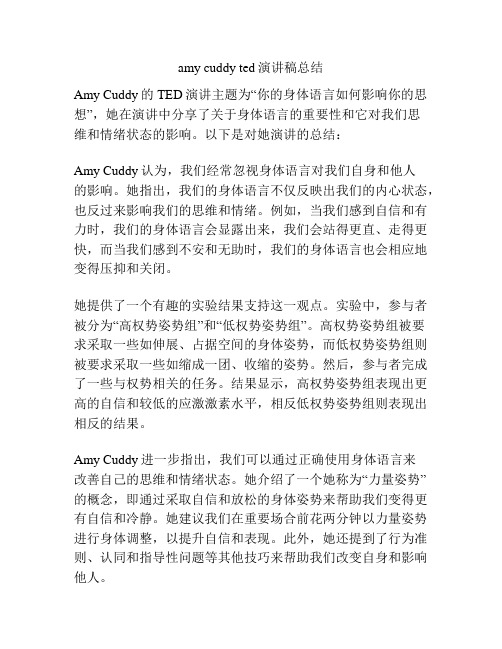
amy cuddy ted演讲稿总结Amy Cuddy的TED演讲主题为“你的身体语言如何影响你的思想”,她在演讲中分享了关于身体语言的重要性和它对我们思维和情绪状态的影响。
以下是对她演讲的总结:Amy Cuddy认为,我们经常忽视身体语言对我们自身和他人的影响。
她指出,我们的身体语言不仅反映出我们的内心状态,也反过来影响我们的思维和情绪。
例如,当我们感到自信和有力时,我们的身体语言会显露出来,我们会站得更直、走得更快,而当我们感到不安和无助时,我们的身体语言也会相应地变得压抑和关闭。
她提供了一个有趣的实验结果支持这一观点。
实验中,参与者被分为“高权势姿势组”和“低权势姿势组”。
高权势姿势组被要求采取一些如伸展、占据空间的身体姿势,而低权势姿势组则被要求采取一些如缩成一团、收缩的姿势。
然后,参与者完成了一些与权势相关的任务。
结果显示,高权势姿势组表现出更高的自信和较低的应激激素水平,相反低权势姿势组则表现出相反的结果。
Amy Cuddy进一步指出,我们可以通过正确使用身体语言来改善自己的思维和情绪状态。
她介绍了一个她称为“力量姿势”的概念,即通过采取自信和放松的身体姿势来帮助我们变得更有自信和冷静。
她建议我们在重要场合前花两分钟以力量姿势进行身体调整,以提升自信和表现。
此外,她还提到了行为准则、认同和指导性问题等其他技巧来帮助我们改变自身和影响他人。
Amy Cuddy的TED演讲引起了广泛的关注和讨论。
她以独特的实验和案例说明了身体语言对我们心理状态的重要影响,并提供了一些实用的改善技巧。
她的演讲给我们带来了重要的思考:我们是否意识到自己的身体语言对我们思维和情绪的影响?我们是否可以通过调整身体姿势来改善自己的自信和表现?这些问题激发了我们对身体语言的更深层次思考和关注。
演讲者的身体语言与肢体表达
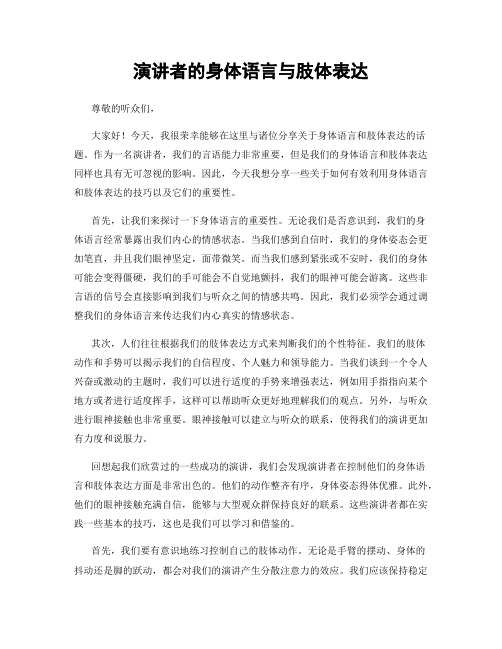
演讲者的身体语言与肢体表达尊敬的听众们,大家好!今天,我很荣幸能够在这里与诸位分享关于身体语言和肢体表达的话题。
作为一名演讲者,我们的言语能力非常重要,但是我们的身体语言和肢体表达同样也具有无可忽视的影响。
因此,今天我想分享一些关于如何有效利用身体语言和肢体表达的技巧以及它们的重要性。
首先,让我们来探讨一下身体语言的重要性。
无论我们是否意识到,我们的身体语言经常暴露出我们内心的情感状态。
当我们感到自信时,我们的身体姿态会更加笔直,并且我们眼神坚定,面带微笑。
而当我们感到紧张或不安时,我们的身体可能会变得僵硬,我们的手可能会不自觉地颤抖,我们的眼神可能会游离。
这些非言语的信号会直接影响到我们与听众之间的情感共鸣。
因此,我们必须学会通过调整我们的身体语言来传达我们内心真实的情感状态。
其次,人们往往根据我们的肢体表达方式来判断我们的个性特征。
我们的肢体动作和手势可以揭示我们的自信程度、个人魅力和领导能力。
当我们谈到一个令人兴奋或激动的主题时,我们可以进行适度的手势来增强表达,例如用手指指向某个地方或者进行适度挥手,这样可以帮助听众更好地理解我们的观点。
另外,与听众进行眼神接触也非常重要。
眼神接触可以建立与听众的联系,使得我们的演讲更加有力度和说服力。
回想起我们欣赏过的一些成功的演讲,我们会发现演讲者在控制他们的身体语言和肢体表达方面是非常出色的。
他们的动作整齐有序,身体姿态得体优雅。
此外,他们的眼神接触充满自信,能够与大型观众群保持良好的联系。
这些演讲者都在实践一些基本的技巧,这也是我们可以学习和借鉴的。
首先,我们要有意识地练习控制自己的肢体动作。
无论是手臂的摆动、身体的抖动还是脚的跃动,都会对我们的演讲产生分散注意力的效应。
我们应该保持稳定的姿势,并避免过度的动作。
此外,我们可以通过镜子练习我们的肢体动作,观察自己的表情和动作在其他人眼中的效果。
其次,我们关注自己的姿态。
保持笔直的背部和站立的姿势会让我们看起来更加自信和专注。
TED演讲观后感-肢体语言塑造你自己
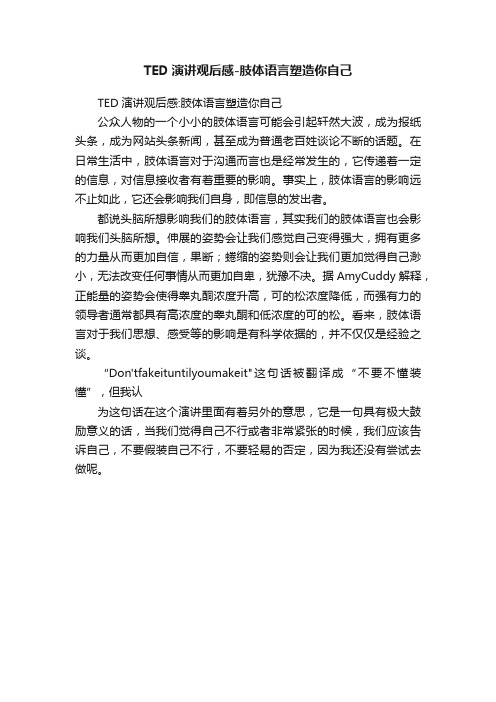
TED演讲观后感-肢体语言塑造你自己
TED演讲观后感:肢体语言塑造你自己
公众人物的一个小小的肢体语言可能会引起轩然大波,成为报纸头条,成为网站头条新闻,甚至成为普通老百姓谈论不断的话题。
在日常生活中,肢体语言对于沟通而言也是经常发生的,它传递着一定的信息,对信息接收者有着重要的影响。
事实上,肢体语言的影响远不止如此,它还会影响我们自身,即信息的发出者。
都说头脑所想影响我们的肢体语言,其实我们的肢体语言也会影响我们头脑所想。
伸展的姿势会让我们感觉自己变得强大,拥有更多的力量从而更加自信,果断;蜷缩的姿势则会让我们更加觉得自己渺小,无法改变任何事情从而更加自卑,犹豫不决。
据AmyCuddy解释,正能量的姿势会使得睾丸酮浓度升高,可的松浓度降低,而强有力的领导者通常都具有高浓度的睾丸酮和低浓度的可的松。
看来,肢体语言对于我们思想、感受等的影响是有科学依据的,并不仅仅是经验之谈。
“Don'tfakeituntilyoumakeit"这句话被翻译成“不要不懂装懂”,但我认
为这句话在这个演讲里面有着另外的意思,它是一句具有极大鼓励意义的话,当我们觉得自己不行或者非常紧张的时候,我们应该告诉自己,不要假装自己不行,不要轻易的否定,因为我还没有尝试去做呢。
ted姿势决定你是谁观后感
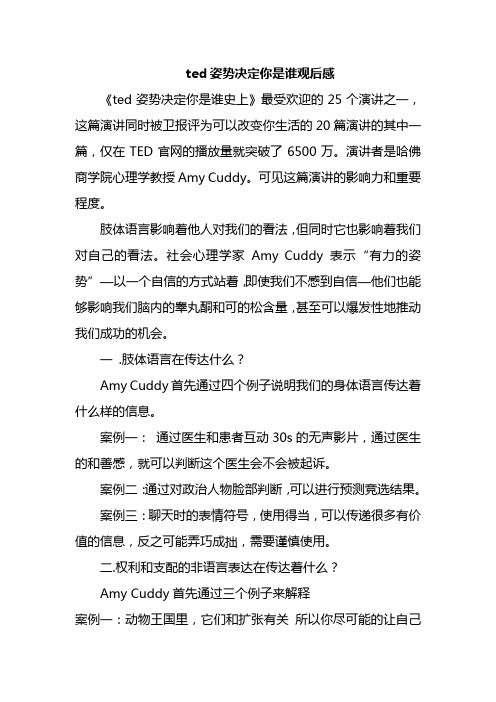
ted姿势决定你是谁观后感《ted姿势决定你是谁史上》最受欢迎的25个演讲之一,这篇演讲同时被卫报评为可以改变你生活的20篇演讲的其中一篇,仅在TED官网的播放量就突破了6500万。
演讲者是哈佛商学院心理学教授Amy Cuddy。
可见这篇演讲的影响力和重要程度。
肢体语言影响着他人对我们的看法,但同时它也影响着我们对自己的看法。
社会心理学家Amy Cuddy表示“有力的姿势”—以一个自信的方式站着,即使我们不感到自信—他们也能够影响我们脑内的睾丸酮和可的松含量,甚至可以爆发性地推动我们成功的机会。
一 .肢体语言在传达什么?Amy Cuddy首先通过四个例子说明我们的身体语言传达着什么样的信息。
案例一:通过医生和患者互动30s的无声影片,通过医生的和善感,就可以判断这个医生会不会被起诉。
案例二:通过对政治人物脸部判断,可以进行预测竞选结果。
案例三:聊天时的表情符号,使用得当,可以传递很多有价值的信息,反之可能弄巧成拙,需要谨慎使用。
二.权利和支配的非语言表达在传达着什么?Amy Cuddy首先通过三个例子来解释案例一:动物王国里,它们和扩张有关所以你尽可能的让自己变大,你向外伸展占满空间,而这同样适用于人类。
当人赢得比赛习惯于双臂呈V型向上,下巴稍微抬起,而当人感到无助时,则习惯于将自己蜷缩起来,让自己变小。
案例二:MBA的学生很善于利用肢体语言。
当他们进入教室,会选择坐在中间,好像他们真的很想占据整个教室似的。
当他们坐下的时候,身体会展开,当他们想要举手时,很有力量。
而有些人,进教室表现的很萎靡。
研究表明,这一结果与他们的性别,课堂参与度有关。
那么,能不能假装参与其中,来减少这些差异?或者你进行假装直到取得成功吗?比如,你做一下下就体验到让你更加有力量的结果。
案例三:当我们高兴的时候我们会笑,但同样地,当我们含着一只笔练习笑容的时候,我们也会感到开心。
总结,非语言掌控他人,非语言同样掌控我们对自己的想法和感受。
演讲中的身体语言展示,塑造演讲者的自信和亲近感
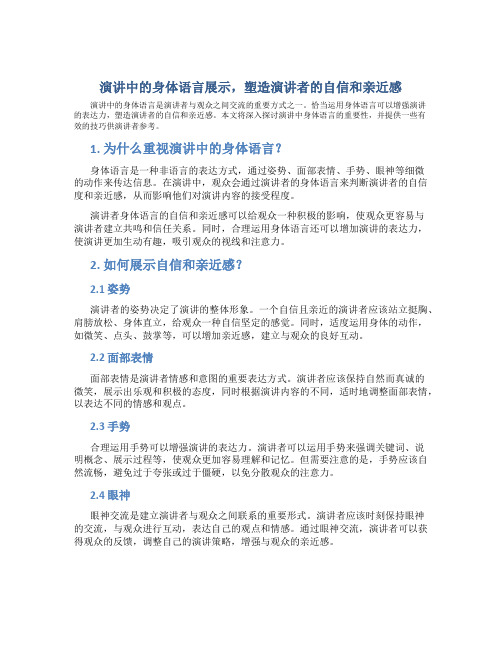
演讲中的身体语言展示,塑造演讲者的自信和亲近感演讲中的身体语言是演讲者与观众之间交流的重要方式之一。
恰当运用身体语言可以增强演讲的表达力,塑造演讲者的自信和亲近感。
本文将深入探讨演讲中身体语言的重要性,并提供一些有效的技巧供演讲者参考。
1. 为什么重视演讲中的身体语言?身体语言是一种非语言的表达方式,通过姿势、面部表情、手势、眼神等细微的动作来传达信息。
在演讲中,观众会通过演讲者的身体语言来判断演讲者的自信度和亲近感,从而影响他们对演讲内容的接受程度。
演讲者身体语言的自信和亲近感可以给观众一种积极的影响,使观众更容易与演讲者建立共鸣和信任关系。
同时,合理运用身体语言还可以增加演讲的表达力,使演讲更加生动有趣,吸引观众的视线和注意力。
2. 如何展示自信和亲近感?2.1 姿势演讲者的姿势决定了演讲的整体形象。
一个自信且亲近的演讲者应该站立挺胸、肩膀放松、身体直立,给观众一种自信坚定的感觉。
同时,适度运用身体的动作,如微笑、点头、鼓掌等,可以增加亲近感,建立与观众的良好互动。
2.2 面部表情面部表情是演讲者情感和意图的重要表达方式。
演讲者应该保持自然而真诚的微笑,展示出乐观和积极的态度,同时根据演讲内容的不同,适时地调整面部表情,以表达不同的情感和观点。
2.3 手势合理运用手势可以增强演讲的表达力。
演讲者可以运用手势来强调关键词、说明概念、展示过程等,使观众更加容易理解和记忆。
但需要注意的是,手势应该自然流畅,避免过于夸张或过于僵硬,以免分散观众的注意力。
2.4 眼神眼神交流是建立演讲者与观众之间联系的重要形式。
演讲者应该时刻保持眼神的交流,与观众进行互动,表达自己的观点和情感。
通过眼神交流,演讲者可以获得观众的反馈,调整自己的演讲策略,增强与观众的亲近感。
3. 注意事项鉴于身体语言在演讲中的重要性,演讲者需要在演讲前做好一些准备工作。
首先,演讲者应该对自己的姿势、面部表情、手势和眼神进行反复练习和调整,以达到自然流畅的效果。
- 1、下载文档前请自行甄别文档内容的完整性,平台不提供额外的编辑、内容补充、找答案等附加服务。
- 2、"仅部分预览"的文档,不可在线预览部分如存在完整性等问题,可反馈申请退款(可完整预览的文档不适用该条件!)。
- 3、如文档侵犯您的权益,请联系客服反馈,我们会尽快为您处理(人工客服工作时间:9:00-18:30)。
TED演讲观后感:肢体语言塑造你自己
公众人物的一个小小的肢体语言可能会引起轩然大波,成为报纸头条,成为网站头条新闻,甚至成为普通老百姓谈论不断的话题。
在日常生活中,肢体语言对于沟通而言也是经常发生的,它传递着一定的信息,对信息接收者有着重要的影响。
事实上,肢体语言的影响远不止如此,它还会影响我们自身,即信息的发出者。
都说头脑所想影响我们的肢体语言,其实我们的肢体语言也会影响我们头脑所想。
伸展的姿势会让我们感觉自己变得强大,拥有更多的力量从而更加自信,果断;蜷缩的姿势则会让我们更加觉得自己渺小,无法改变任何事情从而更加自卑,犹豫不决。
据AmyCuddy解释,正能量的姿势会使得睾丸酮浓度升高,可的松浓度降低,而强有力的领导者通常都具有高浓度的睾丸酮和低浓度的可的松。
看来,肢体语言对于我们思想、感受等的影响是有科学依据的,并不仅仅是经验之谈。
“Don'tfakeituntilyoumakeit"这句话被翻译成“不要不懂装懂”,但我认
为这句话在这个演讲里面有着另外的意思,它是一句具有极大鼓励意义的话,当我们觉得自己不行或者非常紧张的时候,我们应该告诉自己,不要假装自己不行,不要轻易的否定,因为我还没有尝试去做呢。
